|
"The discovery of biface fragments of exotic chert in Chris Lamb's planted field on April
12 and 19, 1986, marked the beginning of a five year project---."--------1999,
Richard Michael Gramly, "The Lamb Site, A Pioneering Clovis
Encampment" p. 19.
"Thousands of
man hours were invested in the Lamb site excavation--."------1999,
Richard Michael Gramly, "The Lamb Site, A Pioneering Clovis Encampment",
p. 2.
"Artifacts
at the Lamb site occurred predominantly in three clusters."----2006,
Bradley T. Lepper & Robert E. Funk, "Paleo-Indian: East,"
Handbook Of North American Indians, Environment, Origins, And
Population, Vol. 3, p. 179.
"The Lamb site was investigated in 1986-1990 by
a team of amateur archaeologists directed by Dr. Richard Michael Gramly."---------1999,
Richard Michael Gramly, "The Lamb Site, A Pioneering Clovis Encampment",
p. back cover page.
"The Lamb
site assemblage has been divided into six primary classes of artifacts,
namely (1) fluted projectile points, (2) fluted knives, (3) preforms and
other bifaces, (4) unifaces, (5) un-shaped flaked tools and, (6)
debitage."---------1999,
Richard Michael Gramly, "The Lamb Site, A Pioneering Clovis Encampment",
p. 36.
"---the strongly
concave bases and long ears of Gainey-like (Debert-like)
northeastern fluted points from Debert, Vail, and Lamb appear to be
derived elaborations of the basic Clovis prototype and should,
therefore, be expected to yield relatively late dates."--------2006,
Stuart J. Fiedel, "Points In Time, Establishing A Precise
Hemispheric Chronology For Paleoindian Migrations," Paleoindian
Archaeology, A Hemispheric Perspective,
p. 39.

LAMB SITE
GENESEE COUNTY, NEW YORK
est. 12,700
(calibrated) years
ago
The discovery of the Lamb site happened in the
same way that most Clovis sites are found. Usually by farmers, surface
collectors, heavy equipment operators, hunters, gardeners or by anyone
else who walks across eroded or otherwise disturbed ground. The first
evidence of the Lamb site turned up in 1965 when John Wells, an employee
of the farm, found an early stage bifacial preform that was made of non
local chert. Chris Lamb later added to the growing collection of bifaces
and a Clovis point base by surface collecting the same small area in one
of the fields. A five year investigation of the site began when
archaeologist R. M. Gramly, PhD. of the Buffalo Museum was sent a local
newspaper that published an article about the Lamb farm and printed a
picture of Curtis Lamb holding a frame of artifacts that were found on
the family farm. |
|
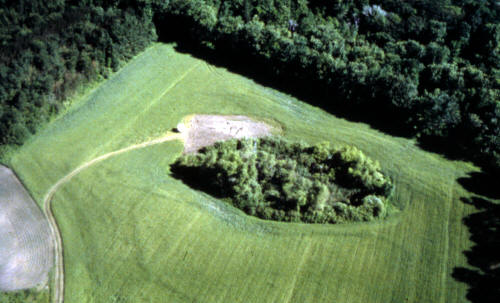
PHOTO CREDIT RICHARD MICHAEL GRAMLY
CLICK ON PICTURE FOR LARGER IMAGE
ARIEL VIEW OF THE LAMB SITE
GENESEE COUNTY, NEW YORK
This picture was taken in 1986 and it
shows an aerial view of the Lamb site. The excavation area can be
seen just above and to the left of the circular tree rimmed pond and
bog terrain in the center of the cultivated field. |
|
|
The Lamb site is located in western New York in
Genesee County near the town of Darien.
The site is situated in a cultivated field on a knoll that is barely six
feet high. Murder creek borders the site and the farm is owned by
Christopher Lamb. |
|
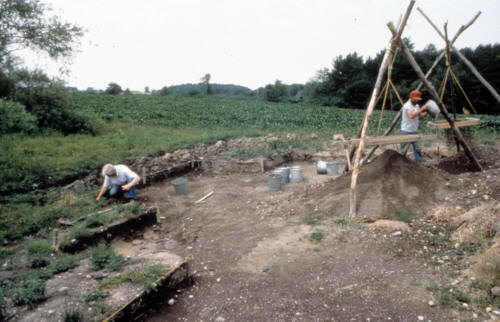
PHOTO CREDIT RICHARD MICHAEL GRAMLY
CLICK ON PICTURE FOR LARGER IMAGE
EXCAVATION AREA
LAMB SITE
GENESEE COUNTY, NEW YORK
This picture was
taken in 1988. It shows a portion of the excavation area of the Lamb
site. Jack Holland at left is uncovering one of the preforms. Chris Lamb
is at right screening dirt. |
|
|
The Lamb site is believed to be a very late Clovis occupation
site. In fact, it's described as
a pioneering Clovis encampment. An estimation of the age of the site
comes from radiocarbon dating and pollen analysis. The samples were
taken from a layer of brown peat where it made contact with a stiff,
gray clay. The clay is a type that is thought to originate from
ice-contact lake glacial moraine deposits. An estimated calendar year
calibrated date for the Lamb site is 12,700 years ago (R.
M. Gramly personal communication). |
|
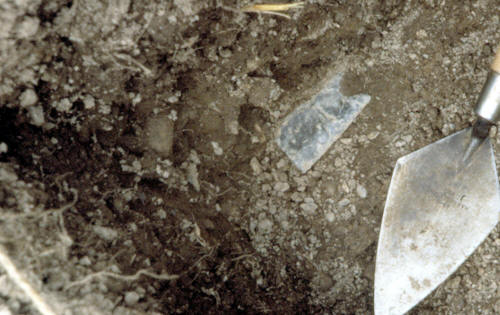
PHOTO CREDIT RICHARD MICHAEL GRAMLY
BASE OF FLUTED POINT
LAMB SITE
GENESEE COUNTY, NEW YORK
This picture shows the base of a fluted point just as it was found
in the area of excavation designated as cluster C on the Lamb site.
This is the location area where ten large fluted points and eleven
bifaces were found. The point and the trowel lie at the very base of
the plow zone. The plow zone is about 12 1/2 inches (32 cm) deep. |
|
|
On site investigation and excavation of the Lamb site
continued for five years from 1986 to 1990. Richard Michael Gramly and a team of
volunteers were able to catalog three distinct groups of artifacts
indicating three different activities. Cluster A, produced a group of
miscellaneous tools that indicated a habitation area. Another area,
designated as cluster B,
produced debris fragments from stone tool manufacturing and a third area,
cluster C,
produced a cache of Clovis points and bifaces. |
|
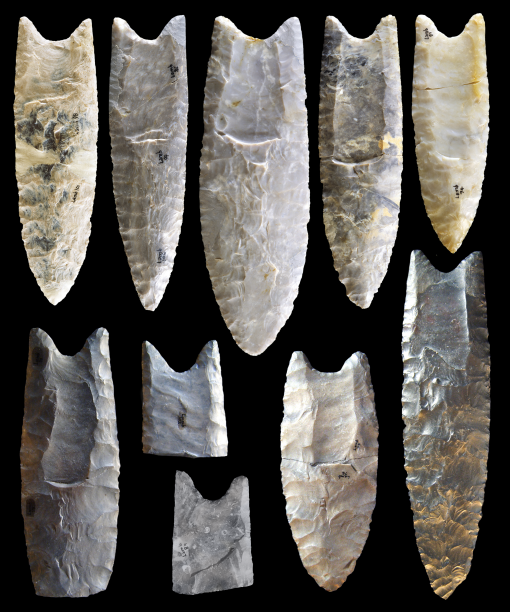
CLICK ON PICTURE FOR LARGER IMAGE
CACHE OF FLUTED POINTS
LAMB SITE
GENESEE COUNTY, NEW YORK
This picture shows all ten of the large fluted points that were
found in the cluster C cache area on the Lamb site. The five
examples in the top row are the original points and four of the five at the bottom are casts
of the original points. The lower broken base is taken from a black
& white photo of the original point. All of the Lamb site fluted points are
broken and fragmented from years
of contact with agricultural equipment. For example, the basal fragment
and the tip-section of the point at bottom right are reported to
have been found 15 meters apart.
Eight of the fluted points in this cache are described as
fluted projectile points. Two of the points in the cache are
described as fluted knives. The large point at top center has been
identified as a fluted knife from use wear that was observed on both
faces near the hafting area and near the tip. The polished areas are
in the form of heavy silica phytolith sheen caused from cutting
plant fibers. The other point that is described as a fluted knife is
second from right bottom row.
Most of the fluted points in the Lamb cache were made from
Ohio or Indiana cherts from the Pennsylvania geological formation.
The point at top right is made of Vanport chert from the Flint
Ridge, Ohio source. The widest point, at top center, is made from
Indiana hornstone. The point at top left is made of a dark brown
semi-translucent chert that is heavily patinated white. It's been
visually identified as Knife River chert from North Dakota but further
technical analysis may change this assessment. If it could be
scientifically proven to be Knife River it would be the farthest
recorded distance that a Clovis artifact was anciently transported.
Although, the source for Knife River is North Dakota, pieces have
been reported from gravels in the Missouri River.
The longest point in the cache, at bottom row right side,
measures 5 1/2 inches (14 cm) long. The widest point at top center
measures 5 1/4 inches (13.4 cm) long and 1 3/4 inches (4.5 cm) wide.
The point in the first row and second from the
right has the longest channel flakes. One measures 2 1/8 inches (5.3
cm) long and the other side measures 2 inches (5.1 cm) long. |
|
|
The large number of
big Clovis points that were found on the Lamb site is unique. Although they were originally intact and complete,
years of contact with agricultural equipment has either fragmented or
broken all of them. Years of cultivation also spread the pieces over a
wide area. Ten fluted points were found in the cluster C cache area. Eight of them are described as projectile points and two of them
are described as knives. |
|
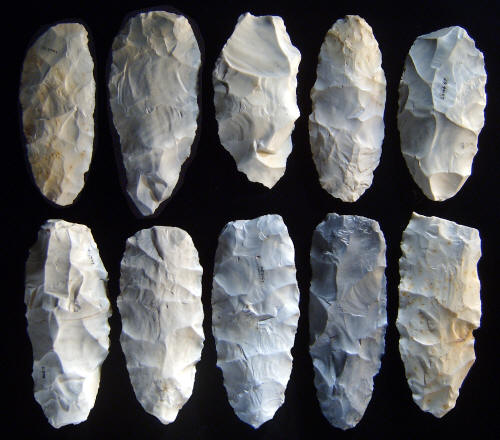
CLICK ON PICTURE FOR BOTH SIDES LARGER IMAGE
BIFACE CACHE
LAMB SITE
GENESEE COUNTY, NEW YORK
The ten bifaces
in this picture are casts of the original bifaces that were found on the Lamb site and identified as a cache. Two fragments of
one additional biface was also found. Most of these bifaces are
described as fluted point preforms. The two examples at top right are described as blocky ovate biface knives.
All of the bifaces were made from light and dark gray and bluish-gray
colored non-local cherts. The material is identified as coming from the
Pennsylvanian geological formation either from Ohio or Indiana. The
longest biface measures 4 1/4 inches (10.7 cm) long. Two of the widest
bifaces both measure 1 3/4 inches (4.4 cm) wide. |
|
|
All ten of the fluted points from the cache area,
designated as cluster C, were made of non-local cherts originating
somewhere outside the state of New York. Most of them are described as
Ohio or Indiana cherts from the Pennsylvania geological formation. One
of the fluted points is identified as Vanport chert from the Flint
Ridge, Ohio source and another is identified as Indiana hornstone. But
the most interesting point is made of a dark brown semi-translucent
chert that is heavily patinated white. It's been visually identified as
Knife River chert from North Dakota but further technical analysis may change
this assessment. If it could be scientifically proven to be Knife River
it would be the farthest recorded distance that a Clovis artifact was
anciently transported. Although, the source for Knife River is North
Dakota, pieces have been reported from gravels in the Missouri River. |
|
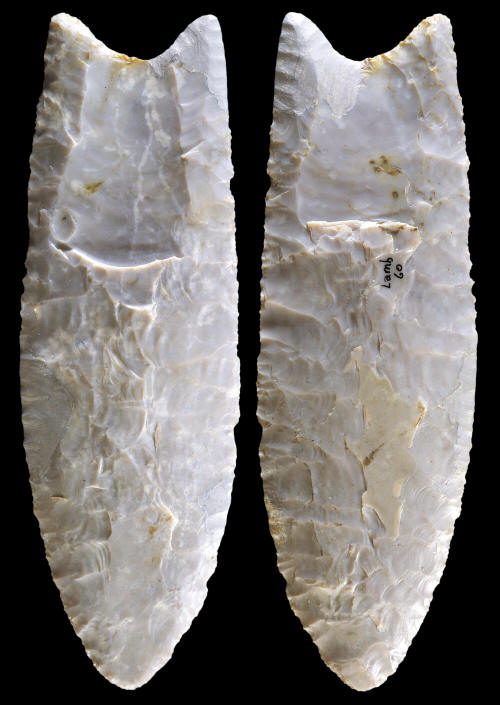
CLICK ON PICTURE FOR LARGER IMAGE
FLUTED KNIFE
LAMB SITE
GENESEE COUNTY, NEW YORK
This is the widest fluted
point that was found in the Lamb site cache of Clovis points. One ear
and a portion of one blade edge has been restored. This Clovis
point was identified as a fluted knife from use wear that was observed
on both faces near the hafting area and near the tip. The polished areas
are identified as a heavy silica phytolith sheen caused from cutting
plant fibers. This point is thought to be made from Indiana hornstone
and it measures 5 1/4 inches (13.4 cm) long and 1 3/4 inches (4.5 cm)
wide. |
|
|
The Lamb site fluted points are "classic" eastern style
Clovis points. They are similar to the western Clovis prototype but the
eastern examples are clear variations. The most obvious difference is
the deeper basal concavities. Western Clovis points tend to be more
shallow while some of the eastern examples from Debert and Vail have
extremely deep concave bases. The eastern fluted points are also known
for very large channel flake removals. |
|
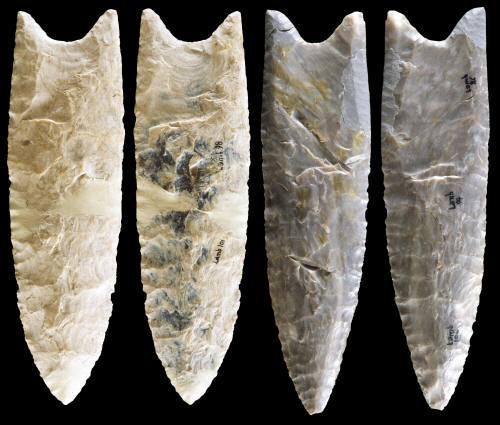
CLICK ON PICTURE FOR LARGER IMAGE
CLOVIS POINTS
LAMB SITE
GENESEE COUNTY, NEW YORK
Both of these Clovis points
were found in the cluster C area where the Lamb site cache of ten fluted
points were found. The point on the left has been restored on the tip of
the point and two triangular segments at the mid-section.
This point is most interesting for the heavily patinated dark brown
semi-translucent chert it's made of. The material has been visually identified as Knife River
chert from North Dakota
but further technical analysis may change this assessment. If it could
be scientifically proven to be Knife River it would be the farthest
recorded distance that a Clovis artifact was anciently transported.
Although, the source for Knife River is North Dakota, pieces have been
reported from gravels in the Missouri River. This point measures 4 9/16
inches ( 11.6 cm) long.
The point on the right was reassembled from three pieces plus
one ear and a portion of one side of the base has been restored. It's made of
Ohio or Indiana chert and it measures 4 13/16 inches (12.2 cm) long. |
|
|
Four small fluted points were also found on the Lamb site.
They were discovered in an area designated as cluster A in the
habitation area. All four of these points were anciently damaged and
discarded. Two of the points are nearly complete. One is missing an ear
and the other is missing an ear and the tip of the point. The longest
example is about 1 3/8 inches (3.5 cm) long. Both of these points were
fire damaged. The other two points are represented by midsections and
are fluted. |
|
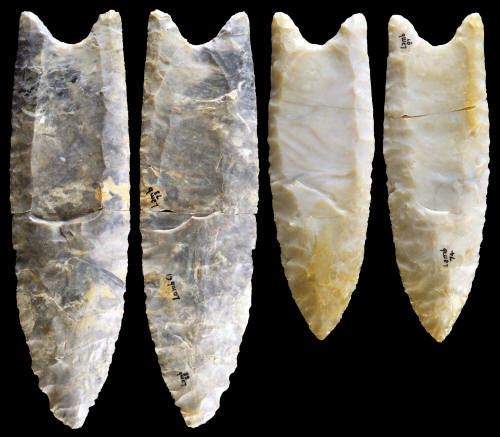
CLICK ON PICTURE FOR LARGER IMAGES
CLOVIS POINTS
LAMB SITE
GENESEE COUNTY, NEW YORK
Both of these points
were found during the excavation of the Lamb site in cluster C where a
cache of 10 points and 11 bifaces were found. Both of these points are
impressive for there "classic" eastern style long channel flute flakes
on both sides and their deep concave bases.
The point on the left is interesting for the fact that it has
the longest channel flakes compared to the nine other points that were in the cache. One measures
2 1/8 inches (5.3 cm) long and the other side measures 2 inches (5.1 cm)
long. This point is complete but was found in three pieces. It measures
4 3/4 inches long (12.1 com) long and it's made of Ohio or Indiana chert
from the Pennsylvania geological formation.
The fluted point on the right is also a complete point but it was
found in two pieces. This fluted point is made of Vanport chert
from the Flint Ridge, Ohio source. It measures 3 5/8 inches (9.2 cm)
long. |
|
|
Seven fragments of a very
large fluted point or knife was also found in the cluster A habitation
area. It's described as being intentionally broken into smaller
pieces for cutting and scraping purposes. The material is identified as
Carter Cave chert. |
|
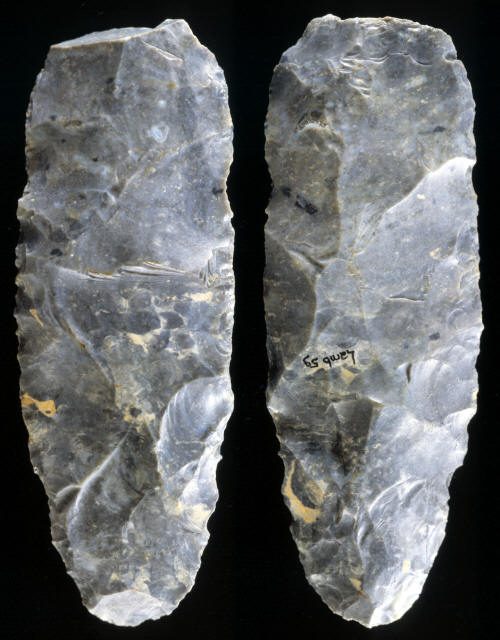
CLICK ON PICTURE FOR LARGER IMAGE
FLUTED POINT PREFORM
LAMB SITE
GENESEE COUNTY, NEW YORK
This picture shows both sides of a
fluted point preform that was found during the excavation of cluster C
where a fluted point and biface cache was found. This early stage
Clovis point preform is made of dark gray Ohio or Indian chert. It
measures 4 3/16 inches (10.7 cm) long and 1 9/16 inches (3.9 cm) wide. |
|
|
Eleven bifaces are
reported to have been found on the Lamb site and identified as a cache. They
are described as fluted point preforms and blocky ovate biface knives.
All of the bifaces were made from light and dark gray and bluish-gray
colored non-local cherts. The material is identified as coming from the
Pennsylvanian geological formation either from Ohio or Indiana. |
|
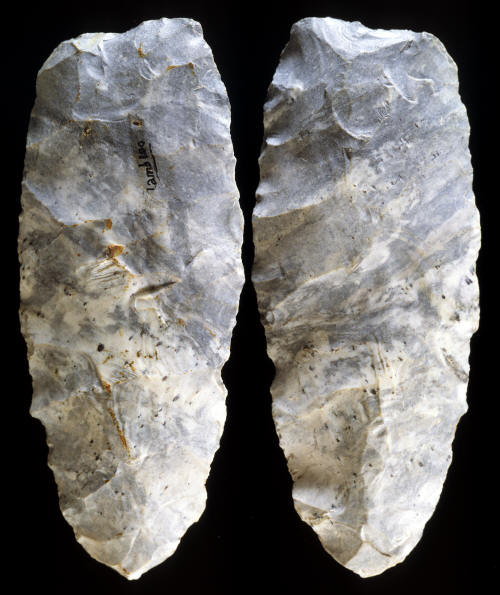
CLICK ON PICTURE FOR LARGER IMAGE
FLUTED POINT PREFORM
LAMB SITE
GENESEE COUNTY, NEW YORK
This fluted point preform
was found on the surface on the Lamb site by Chris Lamb. Its made of
Ohio or Indiana chert from the Pennsylvania geological formation. It
measures 4 1/8 inches (10.5 cm) long and 1 3/4 inches (4.4 cm) wide. |
|
|
The Lamb site was
discovered after a local newspaper published a picture of someone
holding a frame of "arrowheads" So luck still seems to be a factor when
finding these important sites and there probably are many more to find. |
|
"REFERENCES"
1999, Gramly, Richard Michael, "The
Lamb Site, A Pioneering Clovis Encampment" p. 19.
2006, Lepper, Bradley T. & Funk, Robert E., "Paleo-Indian: East,"
Handbook Of North American Indians, Environment, Origins, And
Population, Vol. 3, p. 179.
2006, Fiedel, Stuart J., "Points In Time, Establishing A Precise
Hemispheric Chronology For Paleoindian Migrations," Paleoindian
Archaeology, A Hemispheric Perspective,
p. 39.
Personal Communication, Richard Michael Gramly, PhD.
|
|
RECENT
LISTINGS HOME
ORDERING |